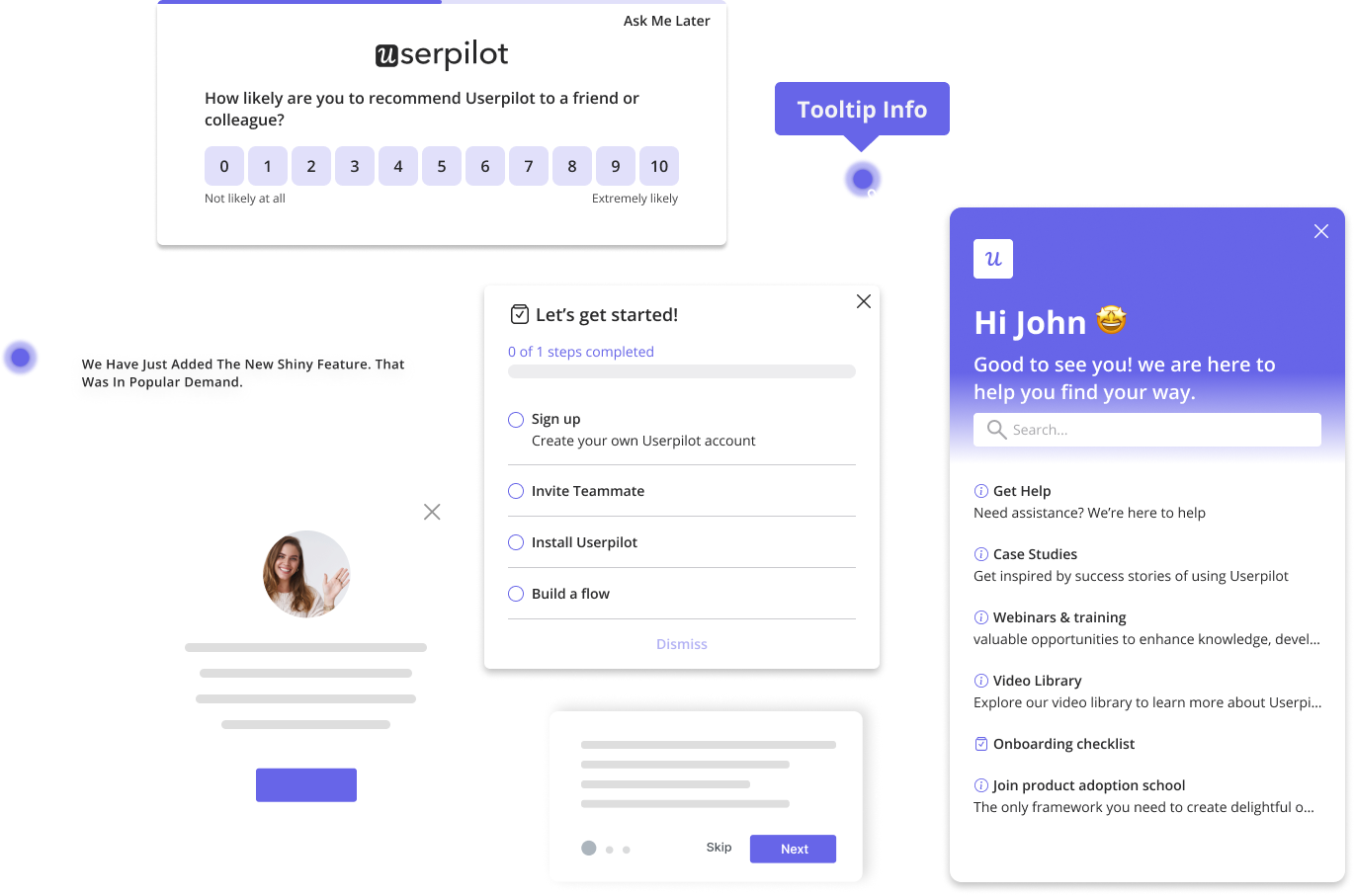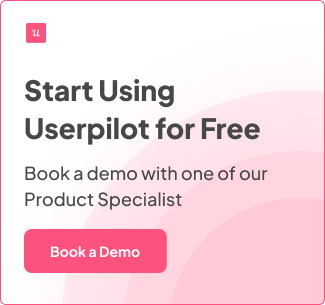In-App Resource Center for SaaS: A Complete Guide [+Examples and Tools]
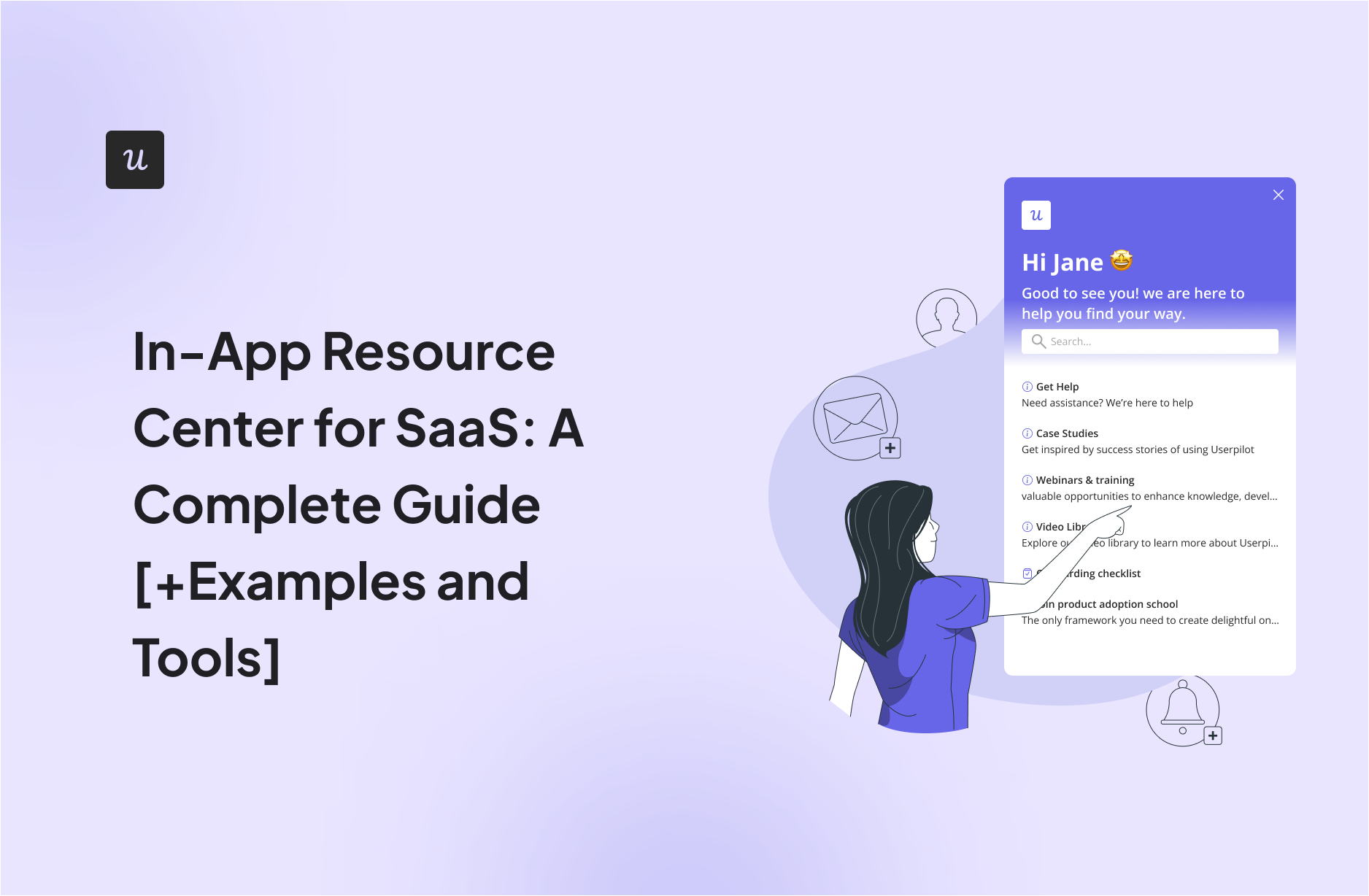
How do you build an in-app resource center that gives customers a valuable self-service experience?
In this article, we cover:
- What to include in your resource center
- 8 SaaS examples to inspire your new resource center
- How to create a help center in just three steps
Let’s get started.
TL;DR
- An in-app resource center is a space where users can find educational content and help articles within the application itself.
- A high-value resource center features a variety of content, including product documentation, product announcements, customer support functions, feedback options, and educational resources.
- It should also have a search function, help articles, and FAQs answering common questions.
Here are 8 SaaS resource centers for inspiration:
- Userpilot has a comprehensive resource center with different module types catering to different user segments. It also features a variety of content formats including videos, product documents, articles, and more.
- Asana designs a sidebar resource center that doesn’t interfere with the user experience.
- Miro uses the power of interactive guides in their resource center. When you click on a guide, you’re taken to a highly engaging and interactive experience.
- Airtable caters to all learning styles by including a wide range of content types in its resource center that include templates, webinars, help articles, etc.
- Amplitude offers customers multiple support options including both community support and a chatbot widget.
- Gleap prioritizes customer feedback in its resource center. They have different buttons to collect feedback for bugs, feature requests, and general product feedback.
- Monday makes convenience a top priority by making its resource center accessible in two locations – from the side menu bar and by clicking on a floating button.
- Figma opted for a lightweight resource center pop-up that doesn’t overwhelm users. They also feature an onboarding replay option so users can go through interactive guides on demand.
- You can create a web app resource center with Userpilot in minutes. Start by adding different help modules for different user segments, add various content formats, and then customize the styling to match your brand.
What is an in-app resource center?
In-app resource centers provide users with help, support, and educational resources within the application itself. It usually features a mix of helpful articles and video tutorials covering frequently asked questions as well as different resource center modules, like a company news section.
When talking about in-app resource centers, terms such as knowledge bases or help centers, can be used interchangeably.
Why do you need an in-app resource center?
SaaS companies need an on-demand in-app resource center to help users make the most of the product. Here’s why:
- It improves the user experience. It improves the UX by making it easy and convenient for users to find quick answers to their questions without leaving the app and the resource center localization ensures global markets receive help in their native languages.
- It enhances user onboarding. In-app knowledge bases are a valuable tool for new users learning how to use your product. They have multiple modules to guide users toward activation and adoption.
- It enhances customer education and drives customer success. When customers can access product education easily, they make faster progress. They experience value at a higher level and more often, which drives higher customer success.
- You get insights regarding customer needs. Review engagement analytics for your in-app resource center to better understand user needs. Use this data to help inform product development and support efforts.
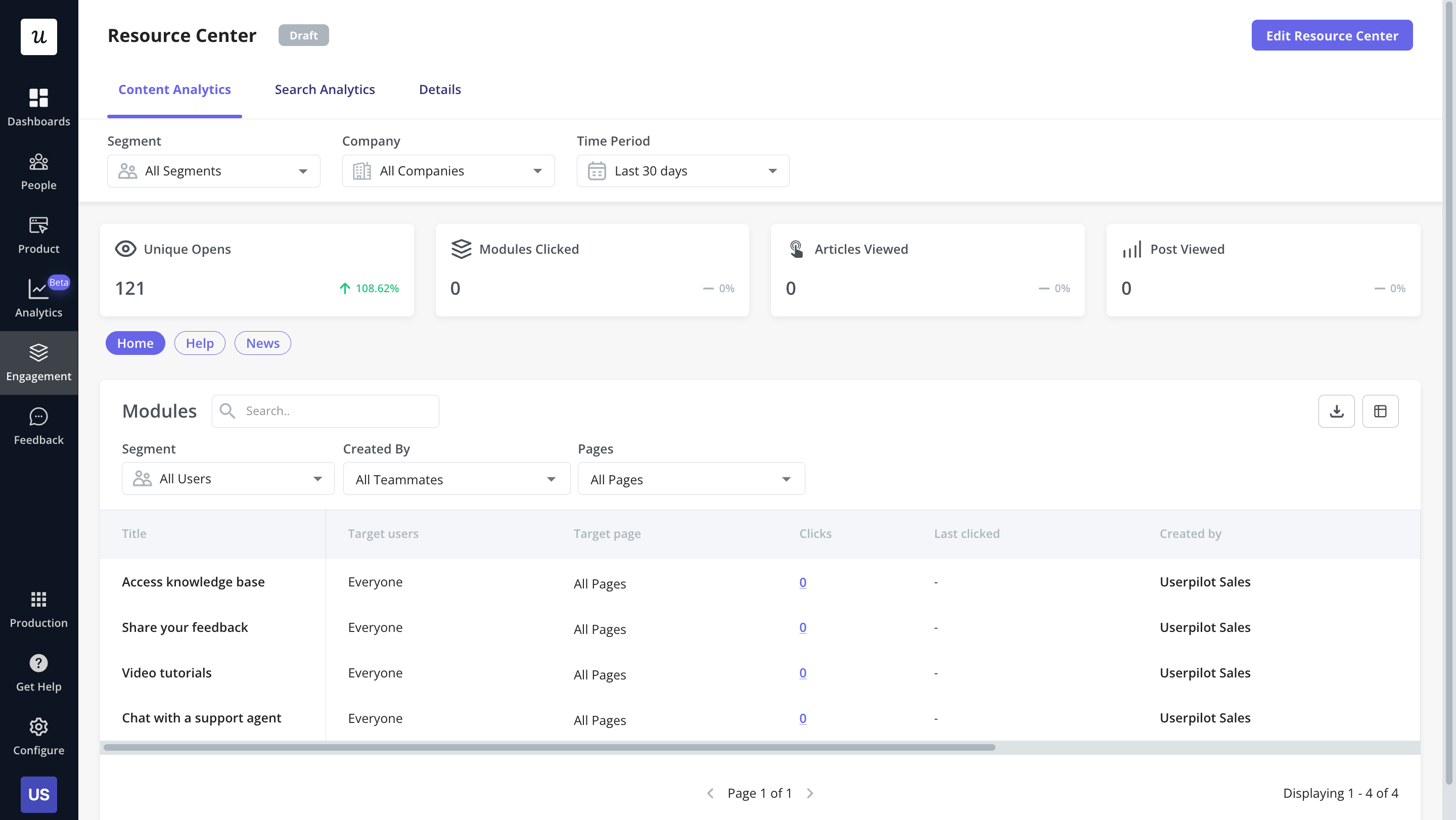
Resource center analytics in Userpilot
What to include in SaaS in-app resource centers
A SaaS resource center should include a variety of content to cater to different needs and learning styles. Here are 8 resources to add when building your in-app resource center:
- Product documentation. This includes technical instructions for setup, configuration, release notes, APIs and SDKs, and troubleshooting. It’s usually geared toward developers who know how to code and configure the software.
- Product announcement. Announce new features or product updates with articles and videos. Add this content to your in-app resource centers to help users adopt the changes.
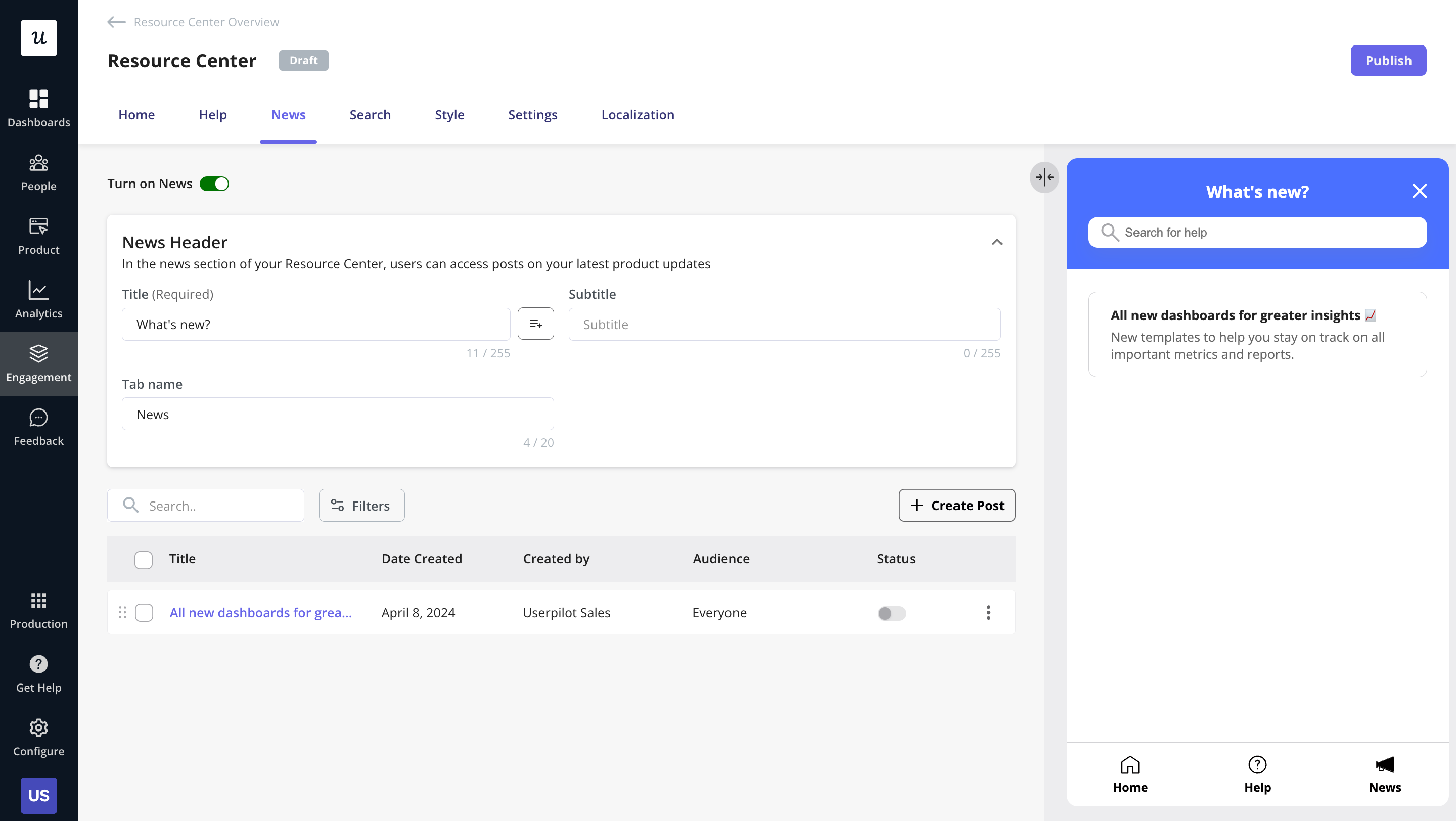
News section in Userpilot‘s resource center
- Customer support function. Give customers an easy way to reach out to your support team if they can’t find the answer to their questions. Resource centers are great for answering the majority of FAQs, but there will be more complex questions that need 1-on-1 help. Add a form or button that makes submitting support tickets simple.
- Feedback options. Collect regular feedback passively from customers by adding a feedback widget to your in-app knowledge base. Ask them how their experience is using your product. Then integrate the feedback into your product roadmap planning.
- Educational resources. Increase product adoption with educational resources like webinars, knowledge base articles, and case studies. For example, host a webinar outlining product use cases so users can visualize the full product functionality. When the webinar is done, add the recording to the help center so they can access it on demand.
- Search function. Add search functionality to your help center so users can find what they need in seconds.
- Help articles. Help articles teach customers how to complete tasks in your SaaS. They walk through the process step-by-step, usually with the help of screenshots, GIFs, and videos.
- FAQs with the most common questions. Getting the same questions over and over? Create a section in your in-app resource center to answer FAQs. Support the content with visuals, such as screenshots.
8 SaaS examples to inspire your own resource center
When it comes to building an in-app resource center, there are a few formats you can try. In this next section, we’ll look at 8 SaaS examples you can take inspiration from.
1. Userpilot – A comprehensive in-app resource center
For an in-app resource center that has it all, take a look at Userpilot’s example for inspiration.
It has comprehensive module types catering to all user segments. It also features a wide range of content formats including videos, knowledge-base articles, webinars, and more.
If users can’t find what they’re looking for, they can trigger a chat with customer support from inside the resource center or search in the search bar.
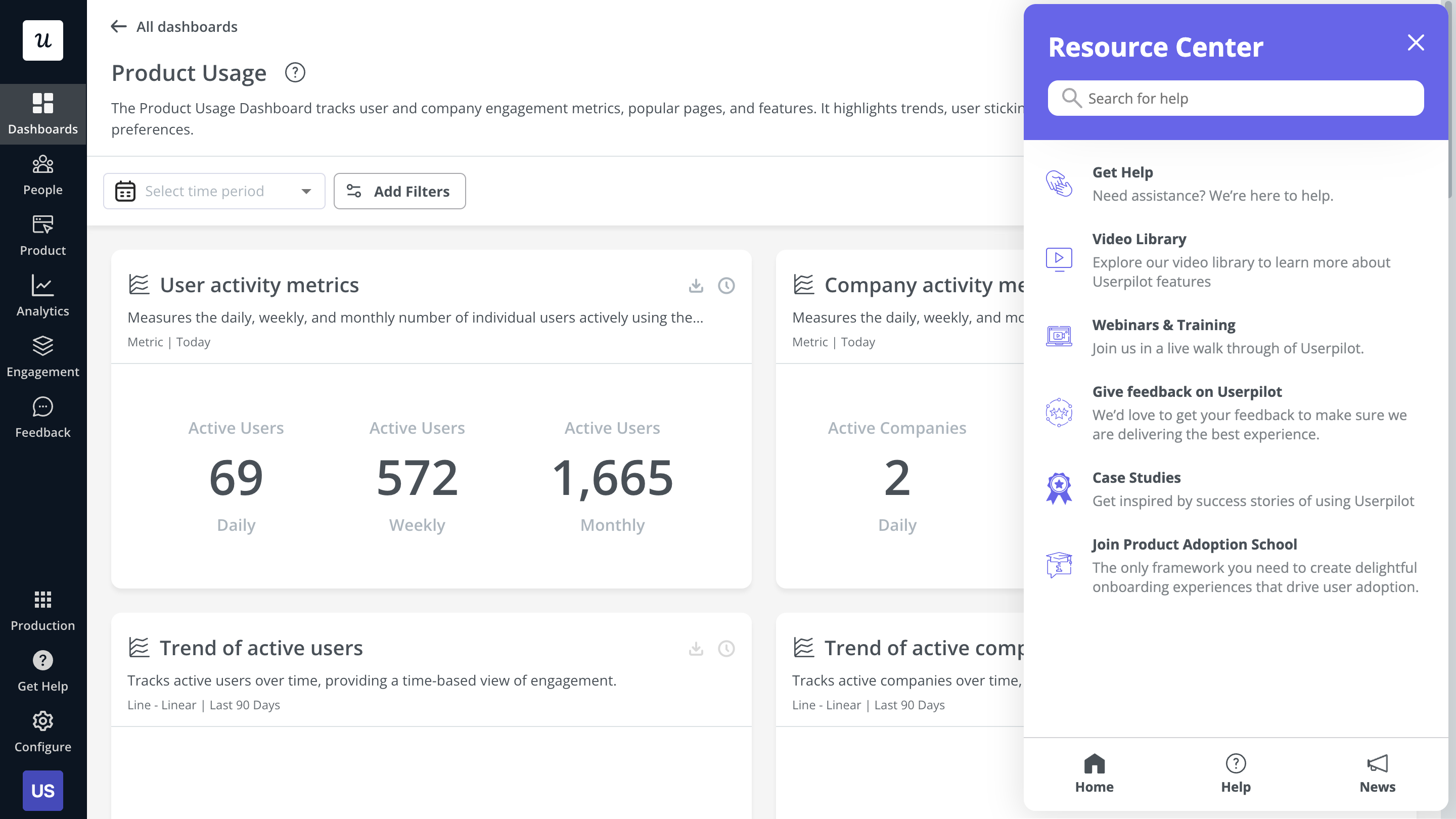
Userpilot’s resource center
2. Asana – A sidebar in-app resource center
If you want to see a subtle design that doesn’t interfere with the user interface, take a look at Asana’s help center. This sidebar-style resource center helps users troubleshoot and get help as they go, enhancing user experience.

Asana’s resource center
3. Miro – An in-app resource center with interactive guides
Interactive guides provide contextual help and let you see the guide in action. This drives higher engagement.
In this example, Miro embeds interactive guides in their in-app learning center. When you click on a guide, you experience an interactive walkthrough.

Miro’s resource center
4. Airtable – An in-app resource center with rich educational resources
In-app resource centers that feature a wide range of educational resources cater to all learning styles. In this example from Airtable, they have templates, help articles, webinars, and community support available.
Bonus tip: Place your help center button in the top navigation bar so it’s easy to spot and access.

Airtable’s resource center
5. Amplitude – An in-app resource center with multiple support options
Customers expect multiple support options so they can find an option that meets their learning preferences. Amplitude does this well with its in-app resource center that features acommunity support section.

Amplitude’s resource center
It also has a chatbot support option in the bottom right corner if customers prefer that route.

Amplitude’s chatbot support
6. Gleap – An in-app resource center with multiple feedback options
As we mentioned earlier, you should be collecting customer feedback in your in-app resource center. In this example, Gleap has three feedback options:
- “Report an issue” button for bug feedback
- “Request a feature” button for feature requests
- “Send us a message” button to collect general product feedback
All three options give valuable insights for the product development team.

Gleap’s resource center
As a bonus, Gleap features its product roadmap and product news inside the in-app resource center.
Users can hear about new feature launches and get on-the-spot guidance for them.
With their public product roadmaps, users can stay up to date on new features coming soon. If they see an exciting feature coming soon, they’ll be way less likely to churn.

Gleap’s product roadmap
7. Monday – An in-app resource center accessible from both sides
Monday prioritizes convenience for their in-app resource center, making it accessible from both sides of the product dashboard.
You can either access it via a side menu bar or by clicking on a floating button.
Making the help guide center instantly accessible means that more users will engage with it and get value from it.

Monday’s resource center
8. Figma – A lightweight resource center with an onboarding replay option
For a simple option that doesn’t overwhelm users, take a look at Figma’s resource center pop-up.
They also have an onboarding replay option where users can find the interactive guides they viewed during onboarding. If they missed it the first time or forgot how to use a feature, this replay option comes in handy to increase feature engagement.

Figma’s resource center
How to create web app resource centers with Userpilot?
There are many knowledge base providers in the market, but your pick should be Userpilot. To create an in-app resource center for your web app, follow these three simple steps in Userpilot’s resource center builder:
- Add different help modules for different user segments
- Add different content formats to your resource center
- Customize your existing knowledge base to match your brand
Let’s explore each step in more detail.
1. Add different help modules for different user segments
Personalize the in-app resource center for different user segments. With Userpilot, modules appear or disappear from the resource center according to the page and audience settings.
Set modules regarding your segment’s needs and goals with your product. They’ll see what’s important to them, improving customer experience.
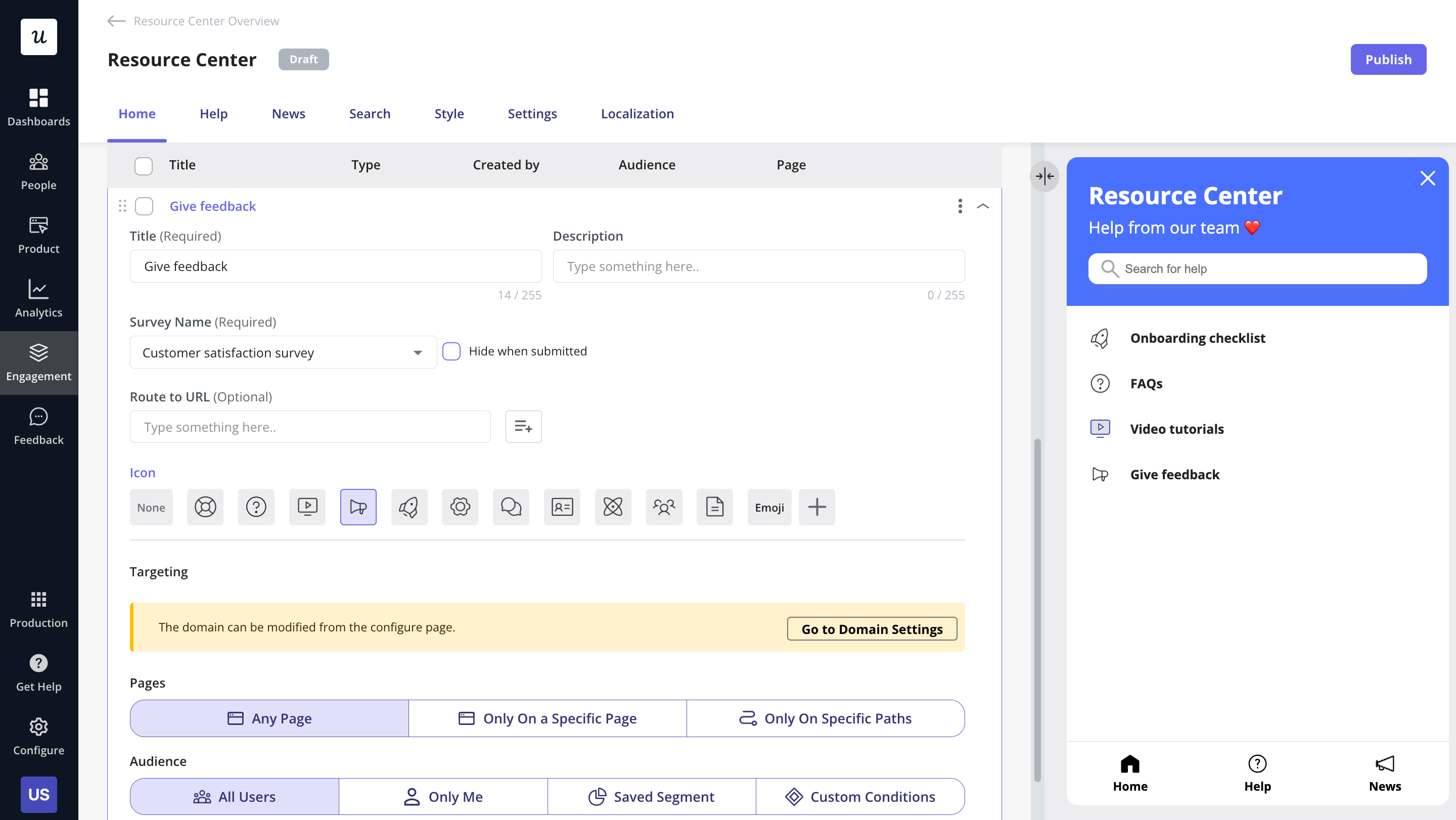
Adding help modules in Userpilot
You can further personalize the resource center for different user segments by localizing it. This will appear as if you’ve created multiple resource centers for different languages, but in reality, you’re just auto-translating one resource center into various languages to create better customer experiences.
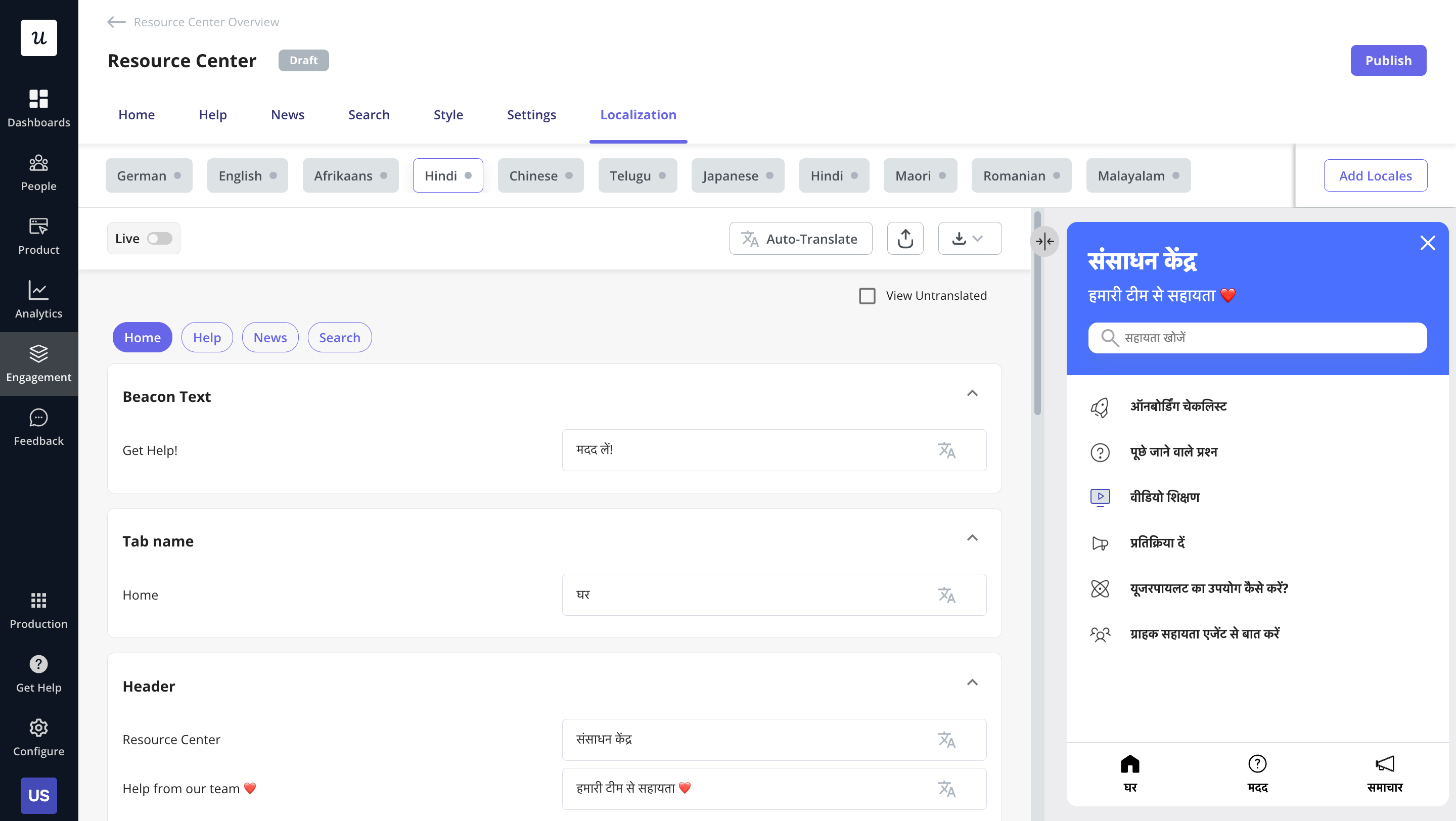
Resource center localization in Userpilot
2. Add different content formats to your resource center
Include a wide range of content formats to cater to different learning styles. Add links, video tutorials, help articles, and a live chat button, among other modules.
With Userpilot, save them as standalone content or group them to build different help categories.
You can also import an existing checklist to the resource center.
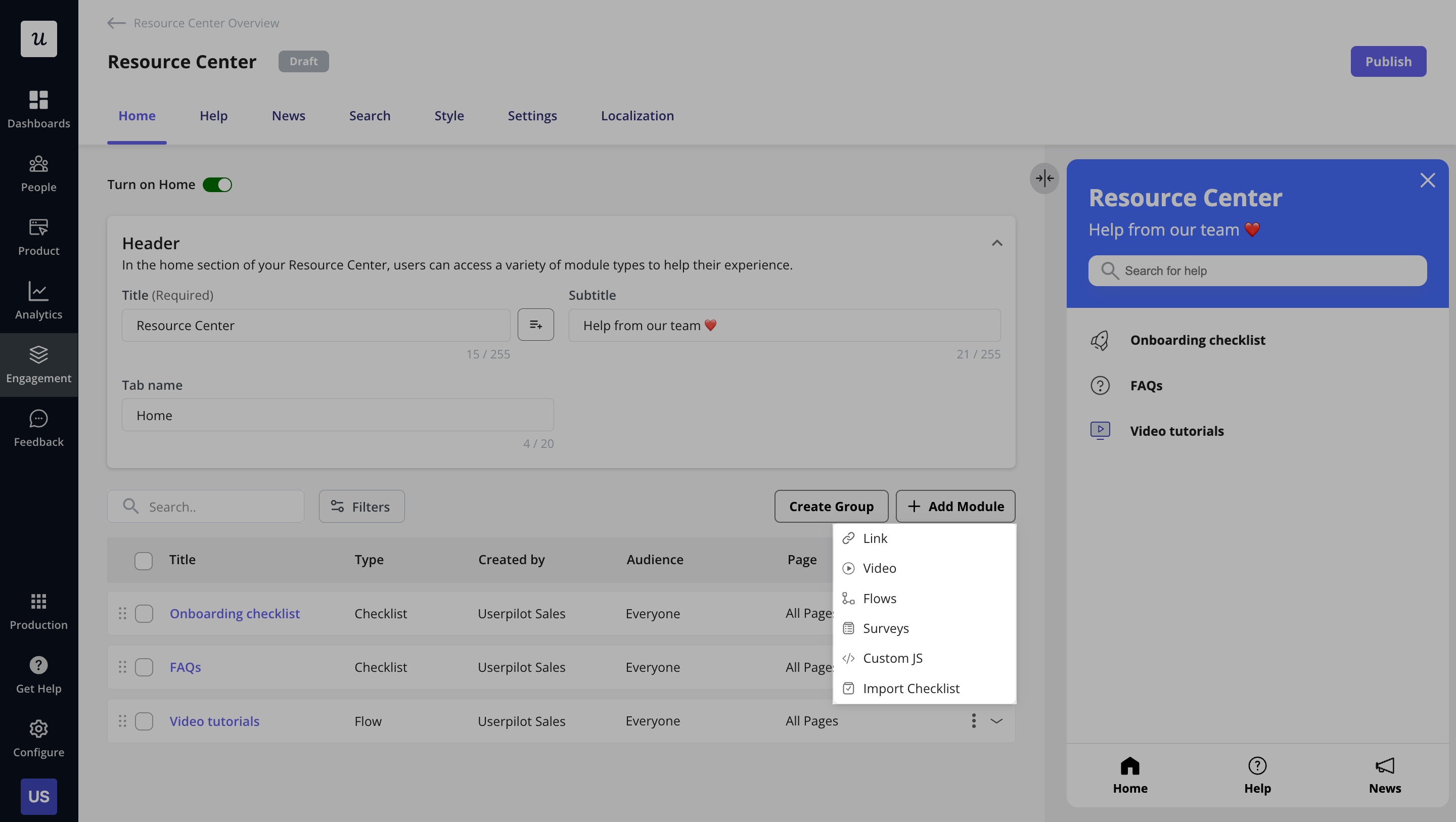
Adding content modules in Userpilot
3. Customize your existing knowledge base to match your brand
Update the colors, font, logo, and button styles to match your branding. You can do this code-free in Userpilot with easy customization options. Before committing to your changes, see a preview of how it will look.
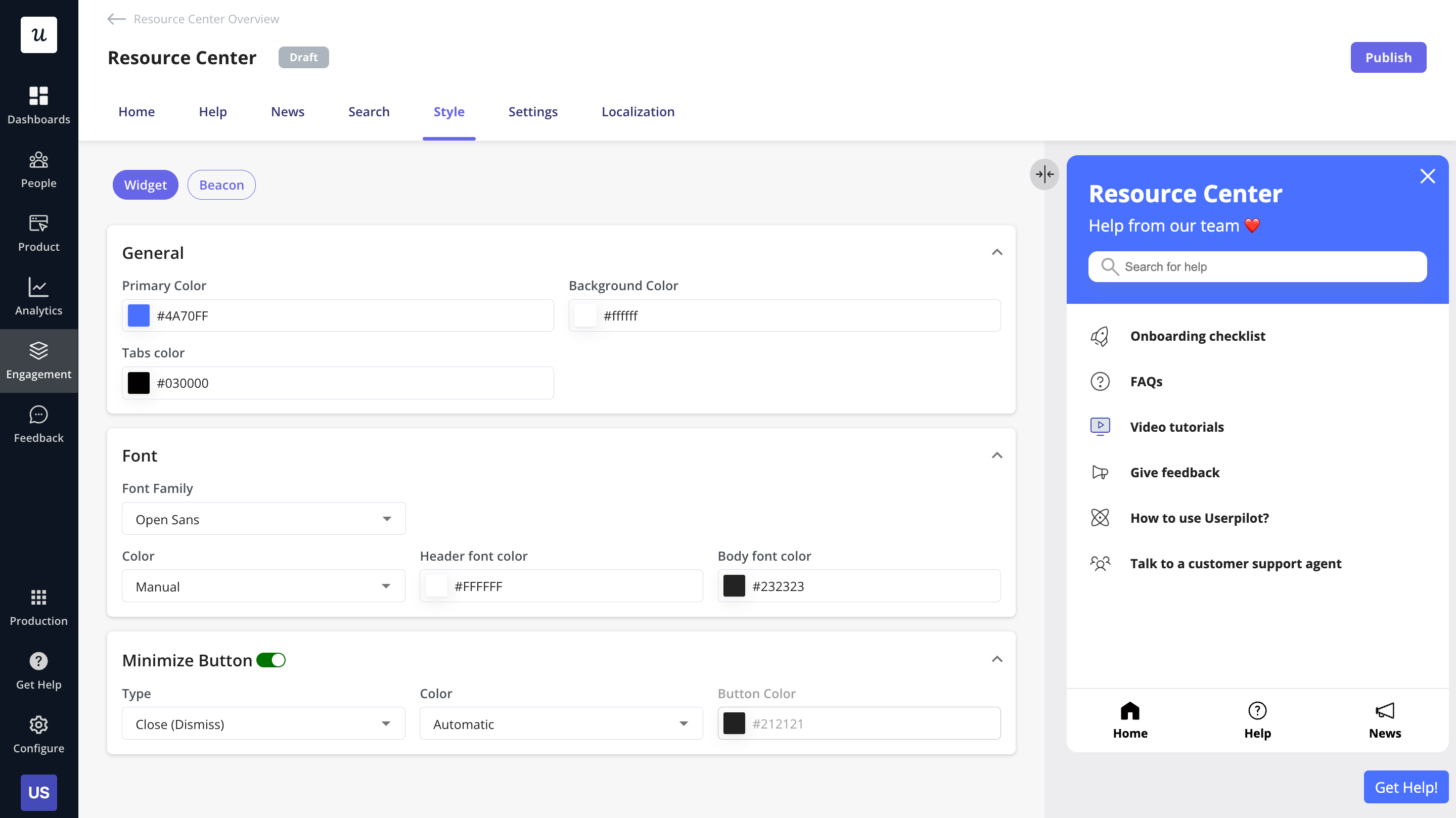
Customize knowledge base styling in Userpilot
Conclusion
Building an in-app knowledge base gives customers access to on-demand help whenever they need it. This improves customer experience and product adoption long-term.
Want to build product experiences code-free? Book a demo call with our team by clicking the link below and get started!
